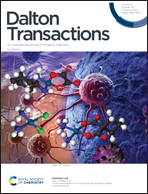A novel symmetric pyrazine (pyz)-bridged uranyl dimer [UO2Cl3(H2O)(Pyz)0.5]22−: synthesis, structure and computational analysis†
Abstract
Herein we report on the synthesis of (HPyz+)2[UO2Cl3(H2O)(Pyz)0.5]2·2H2O which features a novel pyrazine-bridged uranyl dimer, [UO2Cl3(H2O)(Pyz)0.5]22−. A rigorous computational and experimental analysis of this compound was performed to fully explore the influence of coordination on the electronic structure and potential charge-transfer characteristics of this dimer, revealing a delocalized π-system across the bridging pyrazine and the axial components of both uranyl centers. Electrostatic surface potentials, used to rationalize the observed assembly, indicate a decreased basicity of the uranyl oxo versus [UO2Cl4]2−, and signify a lessened capacity for the terminal –yl oxos of the [UO2Cl3(H2O)(Pyz)0.5]22− dimer to participate in supramolecular assembly. A combined density functional theory (DFT) and quantum theory of atoms in molecules (QTAIM) analysis further evidenced an increase in U![[double bond, length as m-dash]](https://www.rsc.org/images/entities/char_e001.gif) O bond strengths within the dimer, which is supported by a blue shift in the characteristic Raman-active uranyl symmetric stretch (ν1) with respect to the more typically observed [UO2Cl4]2−.
O bond strengths within the dimer, which is supported by a blue shift in the characteristic Raman-active uranyl symmetric stretch (ν1) with respect to the more typically observed [UO2Cl4]2−.
![Graphical abstract: A novel symmetric pyrazine (pyz)-bridged uranyl dimer [UO2Cl3(H2O)(Pyz)0.5]22−: synthesis, structure and computational analysis](/en/Image/Get?imageInfo.ImageType=GA&imageInfo.ImageIdentifier.ManuscriptID=D2DT01486F&imageInfo.ImageIdentifier.Year=2022)


 Please wait while we load your content...
Please wait while we load your content...
